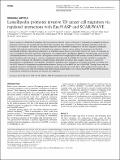Lamellipodin promotes invasive 3D cancer cell migration via regulated interactions with Ena/VASP and SCAR/WAVE
Author(s)
Perera, U.; Gillett, C.; Law, A-L.; Sharma, V. P.; Wang, J.; Mosis, F.; De Piano, M.; Monypenny, J.; Woodman, N.; Mouneimne, G.; Van Hemelrijck, M.; Cao, Y.; Condeelis, J.; Krause, M.; Carmona, Guillaume; Naba, Alexandra; Wyckoff, Jeffrey; Balsamo, Michele; McConnell, Russell E.; Hynes, Richard O.; Gertler, Frank; ... Show more Show less
DownloadGertler_Lamellipodin promotes.pdf (3.570Mb)
PUBLISHER_CC
Publisher with Creative Commons License
Creative Commons Attribution
Terms of use
Metadata
Show full item recordAbstract
Cancer invasion is a hallmark of metastasis. The mesenchymal mode of cancer cell invasion is mediated by elongated membrane protrusions driven by the assembly of branched F-actin networks. How deregulation of actin regulators promotes cancer cell invasion is still enigmatic. We report that increased expression and membrane localization of the actin regulator Lamellipodin correlate with reduced metastasis-free survival and poor prognosis in breast cancer patients. In agreement, we find that Lamellipodin depletion reduced lung metastasis in an orthotopic mouse breast cancer model. Invasive 3D cancer cell migration as well as invadopodia formation and matrix degradation was impaired upon Lamellipodin depletion. Mechanistically, we show that Lamellipodin promotes invasive 3D cancer cell migration via both actin-elongating Ena/VASP proteins and the Scar/WAVE complex, which stimulates actin branching. In contrast, Lamellipodin interaction with Scar/WAVE but not with Ena/VASP is required for random 2D cell migration. We identified a phosphorylation-dependent mechanism that regulates selective recruitment of these effectors to Lamellipodin: Abl-mediated Lamellipodin phosphorylation promotes its association with both Scar/WAVE and Ena/VASP, whereas Src-dependent phosphorylation enhances binding to Scar/WAVE but not to Ena/VASP. Through these selective, regulated interactions Lamellipodin mediates directional sensing of epidermal growth factor (EGF) gradients and invasive 3D migration of breast cancer cells. Our findings imply that increased Lamellipodin levels enhance Ena/VASP and Scar/WAVE activities at the plasma membrane to promote 3D invasion and metastasis.
Date issued
2016-03Department
Massachusetts Institute of Technology. Department of Biology; Koch Institute for Integrative Cancer Research at MITJournal
Oncogene
Publisher
Springer Nature
Citation
Carmona, G., U. Perera, C. Gillett, A. Naba, A.-L. Law, V. P. Sharma, J. Wang, et al. “Lamellipodin Promotes Invasive 3D Cancer Cell Migration via Regulated Interactions with Ena/VASP and SCAR/WAVE.” Oncogene 35, no. 39 (March 21, 2016): 5155–5169.
Version: Final published version
ISSN
0950-9232
1476-5594